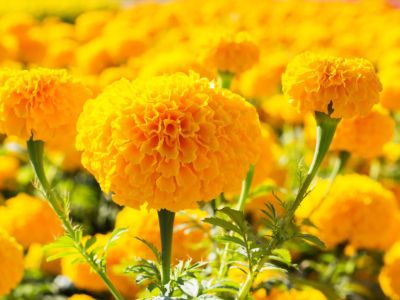Yellow plants as a single color scheme greatly enliven the garden, especially when the area is small or shaded, brightening and enlarging the garden space. Yellow gardens also bring warmth to the landscape at those times of the year when the sun’s rays are not at their peaks, such as spring and autumn.
How to Create a Yellow Garden
When designing garden schemes with yellow plants, beware that a monochromatic planting can look unpleasant. Care must be taken when designing garden schemes with yellow, lest they appear overstimulating rather than being an accenting, calming space. While yellow color schemes lighten darkened areas, they can also be overpowering and are best used sparingly to emphasize other plants. That said, designing garden schemes with yellow, flowering plants placed strategically is a great way to draw the eye to a particular spot in the garden and is often well used with a variety of hues, shapes, and textures. Yellow plants, after all, can be found anywhere within the range of lemon yellows, greenish yellows, amber yellows, and combinations thereof. Groupings of any combination of yellow are sure to make an impression in your yellow garden design but are most visually satisfying when limited to no more than two shades. Also, two separate areas of yellow provide balance and refrain from overwhelming the eye when designing yellow garden schemes.
Yellow Garden Design
Monochromatic garden design is not a new concept; in fact, garden designers such as Gertrude Jekyll and Vita Sackville-West are famous for their single-hued gardens, which pack an overall visual wallop. So, how to create a yellow garden that emulates those created by the above master gardeners? First of all, if using perennials, you will want to consider the bloom time. To stretch the blooming period throughout the season, visit a nursery or garden center every three weeks or so to scout out varieties that will suit your yellow garden design. Select the yellow color schemes that will make the most impact while not overwhelming the yellow garden design. Consider the location. Yellow, as mentioned, reflects more light than any color and is great for lightening up shaded areas.
Yellow Plant Options
Plants such as variegated hosta, yellow coleus, and feverfew (‘Aureum’) will glow in your yellow garden design. Setting yellow plants against dark evergreens, such as golden barberry, elder ‘Aurea’, or yellow leafed ninebark, will highlight not only the evergreen but brighten the locale. Try yellow flowering varieties of the following plants:
Pansy Petunia Marigold Zinnia Rose Rudbeckia Coreopsis Marguerite daisy Columbine Calendula Snapdragon Nasturtium Sunflower Goldenrod Chrysanthemum Dahlia
Remember, less is more and some of these more vibrant yellow plants will do well paired with the cream to pale yellow hues found in ‘Moonbeam’ coreopsis , some daylilies, or rose varieties such as ‘J.P. Connell,’ ‘Windrush,’ or miniature ‘Easter Morning’ and ‘Rise n Shine.’ Of course, spring bulbs of crocus and daffodil and plants such as early primulas or forsythia are always a welcome sight, reminding us that we have survived yet another winter. Iris, such as ‘Harvest of Memories,’ which will rebloom in some climates will make an impact in how to create a yellow garden. Whichever plants you choose when designing garden schemes with yellow, discovering the correct combination may be a bit of trial and error but will surely result in an effective and gloriously eye-catching landscape.
